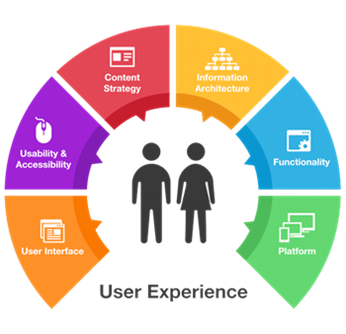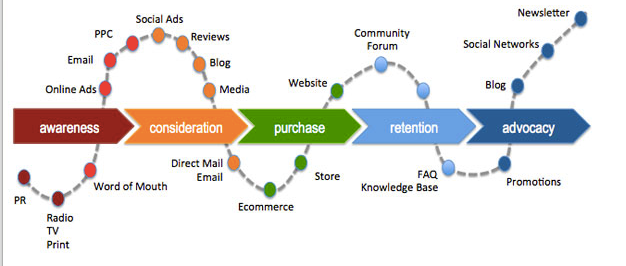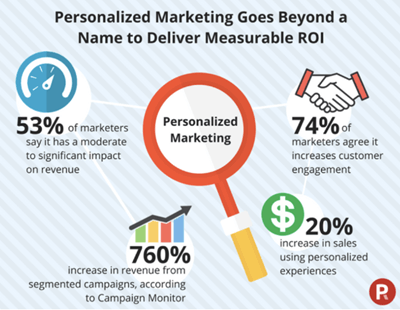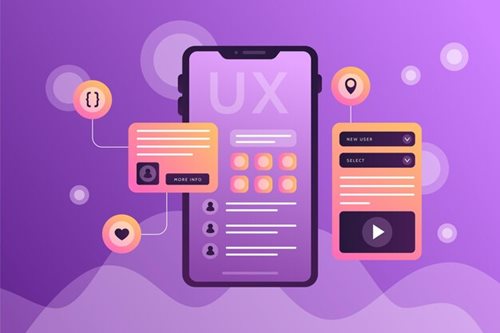Get your free consultation today!
Share with your Colleagues
Categories
ROI Calculator
Moonstone Interactive is the only San Francisco Bay Area web design firm and Internet Marketing expert that offers a free online ROI Calculator
Author: Steve Herz

Customers are demanding personalization in their interactions with businesses more and more and businesses are investing in technology that can provide personalization—but are not necessarily implementing it along those customers’ path to purchase, or along their customer journey.
Each step of the customer journey presents personalization opportunities to offer different content aligned to the specific characteristics of each person—if you know which data to capture and use for higher customer engagement and a better overall customer experience.
It’s becoming increasingly important to focus on personalizing every interaction across every channel. More sophisticated CMS platforms can help identify personas (generalized representations of your ideal customers) based on the customer journey and deliver personalized website content based on where those customers are in their path.
Content management—with the right content strategy and analytics—is critical to deliver personalized experiences faster and better.
Here are 3 key strategies to integrate content management and personalization into the customer journey, improving the overall customer experience and increasing ROI.
 1) Use data to understand the customer journey and to align different types of personalization to each step.
1) Use data to understand the customer journey and to align different types of personalization to each step.
Step 1 of the Customer Journey: Discovery and the First Time Visitor
The goal in the first step of the customer journey is to reduce bounce rates and to convert anonymous visitors into actual leads. From the very first impression, you can use the following implicit data for personalization:
- Search Keywords
- Referring website / page
- Campaign Parameters
- Landing Page
- Location
- IP Address
- Demographics
- Company Name
- Time of Day
- Type of Browser
Step 2 of the Customer Journey: Consideration and Profiling
 The first few clicks provide a chance to generate a conversion if you can provide a compelling, relevant message or resource with an appropriate call to action. At this stage you can implement personalization by combining additional data—such as prior visits, pages viewed and time on site—with CRM data to augment visitors’ profiles and:
The first few clicks provide a chance to generate a conversion if you can provide a compelling, relevant message or resource with an appropriate call to action. At this stage you can implement personalization by combining additional data—such as prior visits, pages viewed and time on site—with CRM data to augment visitors’ profiles and:
- classify them into personas
- assess purchase intent through lead scoring
- predict conversion propensity through algorithms
Step 3 of the Customer Journey: Conversion and Predictive Analytics
The goal at this stage is to identify the customer to help improve and optimize conversion rates. A combination of valuable content, resource materials, and calls to action can be used to:
- minimize navigation, accelerate path
- promote more relevant. compelling offers
- ask for data with forms
- increase personalization via email
- earn access to social data
Step 4 of the Customer Journey: Retention and Account-Based Data
A purchase does not mean the end of personalization. After a purchase, you have
- purchase history,
- address, and
- customer satisfaction indicators
to provide relevant offers, cross-sell related products / services, and to open new channels for marketing, such as mobile, text and print.
2) Use a customer journey map to customize each of the four steps to your business.
A customer journey map illustrates the relationship between a potential customer and your business throughout the touch points of your sales process. Told from the customer’s perspective, it helps your business understand customer needs and address their pain points to increase the possibility of conversion.
A customer journey map:
- Provides value-added customer experiences
- Builds faster and higher conversion rates
- Improves customer retention, brand loyalty
- Ensures the correct/relevant information is available and accessible
- Provides opportunities to bring customers back on board
- Allows businesses to prioritize actions in their customer experience strategy
- Reveals gaps between channels and departments

Six steps to creating your own customer journey map.
1. Define a persona for the journey
Identify the needs, behaviors and attributes of your best customers. Group the customers into similar clusters of characteristics as your Personas. Decide whose journey you are going to map to specifically describe that persona’s experience at various touch points during their life cycle with your business.
2. Determine customer engagement stages
Consider the process it takes from discovery all the way through buying your product or service. Based on the chosen persona, define the specific stages your customer experiences with you over time. Include how, when and where they: discover your company, research your products or services, choose you over competitors, purchase from you, and maintain a relationship with you.
3. Describe customer touch points
Identify your points of customer contact or of influential action from start to finish, including: finding your business online, reading reviews, visiting your website, shopping at your retail store, or contacting customer service.
4. Conduct research about customer expectations
For each stage go deeper and identify: goals and expectations, feelings and thoughts, touch points used and time spent in each
5. Determine points of friction
Identify if there is friction at any particular touch point, if customers are abandoning purchases, or whether customers are not aware of solutions you already provide.
6. Resolve opportunities to improve customer experience
Identify a few opportunities to boost engagement and improve the customer journey, ultimately improving the overall customer experience and increasing ROI.
3) Use content management best practices that solve the challenges of personalization and support the customer journey.
For the greatest efficiency and effectiveness, use an enterprise-level integrated CMS and Marketing platform, such as Kentico EMS or Optimizely
- Use structured content
Structured content means content that is separated into independent fields or chunks, making its behavior more predictable. It can take longer to setup, but provides great scalability benefits for personalization. - Separate presentation from content
Have personalized content live independently and ready to be reused, keeping appearance and structure separate. - Use custom classifications
Look for systems that enable filtering by industry, geography, persona, client type etc. and embed this in your information architecture. - Focus on personas as a personalization criteria
Persona definition is a crucial step for any marketing effort and a way to ensure the buyers’ best interests. Focus on two to three personas to make it easy to think about separate messages. You can then increase the number of personas as needed based on what you learn. - Integrate data from all channels
Look at your customers’ experiences as the connected experiences they are. Use the connections between interactions on a mobile app, on the website, and through email to inform your personalization decisions. - Set identification as a conversion goal
Commit to significantly increasing the number of known users you have in your system through form submission, white paper download, log in or any other method. - Measure Personalization against short- and long-term goals
Have a good mix of short- and long-term goals when you measure the effectiveness of personalization—from the download of an asset or a webinar registration to a sale and customer lifetime value.
Are you ready to implement personalization according to the customer journey?
 Improving your customer journey can be one of the most effective ways to boost online conversions and sales, but creating integrated personalization strategies based on such journey can be a challenge. In fact, even though leading online retailers, like Amazon personalize the experience across the sales process, few competing retailers are taking advantage of the data available for such personalization. Do you want to beat your competition? We can help get you a step ahead and set the groundwork for an optimized plan to drive ROI using personalization in your customer journey.
Improving your customer journey can be one of the most effective ways to boost online conversions and sales, but creating integrated personalization strategies based on such journey can be a challenge. In fact, even though leading online retailers, like Amazon personalize the experience across the sales process, few competing retailers are taking advantage of the data available for such personalization. Do you want to beat your competition? We can help get you a step ahead and set the groundwork for an optimized plan to drive ROI using personalization in your customer journey.
Let’s discuss the benefits of using Customer Journey Maps to Increase your results.



